Related Research Articles

The history of Vietnam can be traced back to around 20,000 years ago. The first modern humans to arrive and settle in the area of modern-day Vietnam are known as the Hoabinhians, who can be traced as the ancestors of modern-day Negritos. Archaeological findings from 1965, which are still under research, show the remains of two hominins closely related to the Sinanthropus, dating as far back as the Middle Pleistocene era, roughly half a million years ago.

The Nguyễn dynasty was the last Vietnamese dynasty, which was preceded by the Nguyễn lords and ruled the unified Vietnamese state independently from 1802 to 1883 before being a French protectorate. During its existence, the empire expanded into modern-day southern Vietnam, Cambodia, and Laos through a continuation of the centuries-long Nam tiến and Siamese–Vietnamese wars. With the French conquest of Vietnam, the Nguyễn dynasty was forced to give up sovereignty over parts of southern Vietnam to France in 1862 and 1874, and after 1883 the Nguyễn dynasty only nominally ruled the French protectorates of Annam as well as Tonkin. They later cancelled treaties with France and were the Empire of Vietnam for a short time until 25 August 1945.
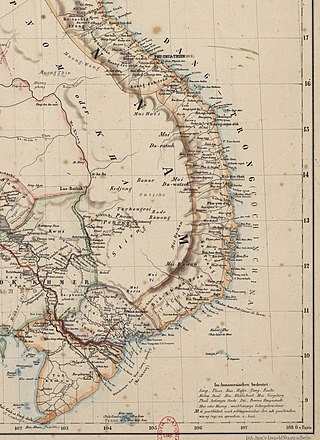
Cochinchina or Cochin-China is a historical exonym for part of Vietnam, depending on the contexts. Sometimes it referred to the whole of Vietnam, but it was commonly used to refer to the region south of the Gianh River.
Articles related to Vietnam and Vietnamese culture include:

Da Nang or Danang is the fourth-largest city in Vietnam by municipal population. It lies on the coast of the East Sea of Vietnam at the mouth of the Hàn River, and is one of Vietnam's most important port cities. As one of the country's five direct-controlled municipalities, it falls under the administration of the central government.
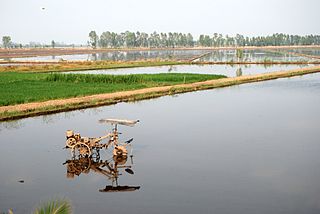
The Mekong Delta, also known as the Western Region or South-western region, is the region in southwestern Vietnam where the Mekong River approaches and empties into the sea through a network of distributaries. The Mekong delta region encompasses a large portion of south-western Vietnam of over 40,500 km2 (15,600 sq mi). The size of the area covered by water depends on the season. Its wet coastal geography makes it an important source of agriculture and aquaculture for the country.
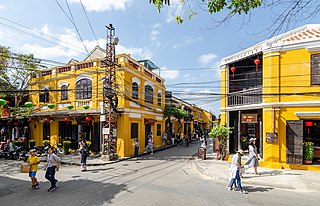
Quảng Nam is a coastal province near northernmost part of the South Central Coast region, the Central of Vietnam. It borders Thừa Thiên Huế to the north, Đà Nẵng to the northeast, Kon Tum to the southwest, Quảng Ngãi to the southeast, Sekong of Laos to the west and the East Sea to the east.

Phú Quốc is the largest island in Vietnam. Phú Quốc and nearby islands, along with the distant Thổ Chu Islands, are part of Kiên Giang Province as Phú Quốc City. The island has a total area of 589.27 km2 (227.52 sq mi) and a permanent population of approximately 179,480 people in 2020. Located in the Gulf of Thailand, the island city of Phú Quốc includes the island proper and 21 smaller islets. Dương Đông ward, located on the island's west coast, is the island's administrative centre and largest town. The other ward is An Thới on the southern tip of the island.
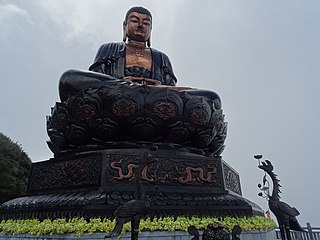
Buddhism in Vietnam, as practiced by the Vietnamese people, is a form of East Asian Mahayana Buddhism. It is the main religion in Vietnam. Vietnamese Buddhism is generally inclusive and syncretic, drawing on the main Chinese Buddhist traditions, such as Tiantai and Huayan, Zen (Thiền), and Pure Land.

Lý Nhân Tông, personal name Lý Càn Đức, temple name Nhân Tông was the fourth emperor of the Lý dynasty, ruling the kingdom of Đại Việt from 1072 until his death in 1128. Succeeding his father Lý Thánh Tông at the age of 7, during his early reign Lý Nhân Tông ruled with the assistance of his mother Ỷ Lan and the chancellor Lý Đạo Thành who were both considered competent regents and were able to help the emperor maintain the country's prosperity. Appreciated as a great emperor of the Lý dynasty, Lý Nhân Tông made important contributions to the development of Đại Việt, especially for establishing Confucianism as the official philosophy of the state, creating Confucian-based imperial exams, and creating schools based on the Confucian system of learning. During his 55-year reign, which was the longest reign for any Vietnamese monarch, Lý Nhân Tông also experienced several wars against Đại Việt's neighbours, the Song dynasty and the kingdom of Champa in which the Sino–Vietnamese War (1075–1076) was the fiercest. After his death, the royal family lost their control over the court to the chancellors and the bureaucracies.

Notre-Dame Cathedral Basilica of Saigon, officially Cathedral Basilica of Our Lady of The Immaculate Conception is a cathedral located in the downtown of Ho Chi Minh City, Vietnam. Established by French colonists who initially named it the Church of Saigon, the cathedral was constructed between 1863 and 1880. The name Notre-Dame Cathedral has been used since 1959. It has two bell towers, reaching a height of 58 meters (190 feet).

Northern Vietnam, Central Vietnam and Southern Vietnam are the three main historical, geographical and cultural regions within Vietnam. Each region consists of subregions, with considerable cultural differences originating from each subregions.

Đại Việt, was a Vietnamese monarchy in eastern Mainland Southeast Asia from the 10th century AD to the early 19th century, centered around the region of present-day Hanoi, Northern Vietnam. Its early name, Đại Cồ Việt, was established in 968 by Vietnamese ruler Đinh Bộ Lĩnh after he ended the Anarchy of the 12 Warlords, until the beginning of the reign of Lý Thánh Tông, the third emperor of the Lý dynasty. Đại Việt lasted until the reign of Gia Long, the first emperor of the Nguyễn dynasty, when the name was changed to Việt Nam in 1804. Under rule of bilateral diplomacy with Imperial China, it was known as Principality of Giao Chỉ from (975-1164) and Kingdom of Annam from (1164-1804) when Emperor Xiaozong of Song upgraded Đại Việt's status from Principality to Kingdom.
Indians in Vietnam consist of migrants to Vietnam from India, both historical and recent. As of 2011, there were about 2,000 people of Indian origin settled in Vietnam, mainly in Ho Chi Minh City. Prior to the Vietnam War, there was a vibrant Indian community consisting of primarily Tamils, and specifically the Chettiars.

Tôn Thất Thiện (1924–2014) was a South Vietnamese nationalist of the post-World War II generation who had the rare distinction of serving and watching at close quarters the two historic leaders of post-World War II Vietnam: presidents Ho Chi Minh in the Viet Minh coalition in 1945–46, and Ngô Đình Diệm 1954–55/1956–59/1963. He played a significant though understated role in the nationalist attempt to preserve a non-Communist Vietnam.
Emperor Lý Anh Tông of Đại Việt was the sixth emperor of the later Lý dynasty, from 1138 until his death in 1175. Since Lý Anh Tông, given name Lý Thiên Tộ, was chosen as the successor of his father Lý Thần Tông at the age of only two, the early period of his reign witnessed the dominant position of Đỗ Anh Vũ in the royal court until his death in 1157, afterwards the Emperor ruled the country with the assistance of a prominent official named Tô Hiến Thành. The reign of Lý Anh Tông was considered the last relatively stable period of the Lý dynasty before the turbulence during the reign of Lý Cao Tông.

Lưu Hữu Phước was a Vietnamese composer, a member of the National Assembly, and Chairman of the Committee of Culture and Education of the National Assembly of the Socialist Republic of Vietnam.
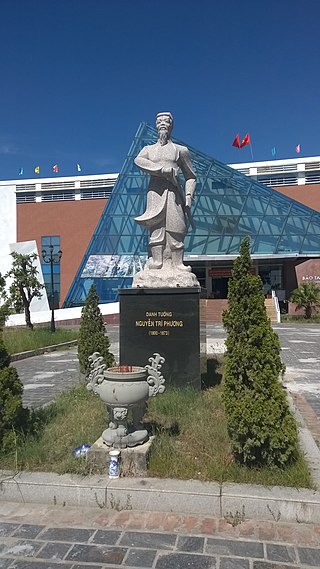
Nguyễn Tri Phương, born Nguyễn Văn Chương, was a Nguyễn dynasty mandarin and military commander. He commanded armies against the French conquest of Vietnam at the Siege of Tourane, the Siege of Saigon and the Battle of Hanoi (1873).
The địa danh, also known as tên chữ are Sino-Vietnamese names that are used for Vietnamese place names. The reasoning behind the names are for official and historical usage by the government which uses Hán văn in official documents.

Vietnamese folk religion is a group of spiritual beliefs and practices adhered by the Vietnamese people. About 86% of the population in Vietnam are reported irreligious, but are associated with this tradition.
References
- ↑ Alexander Woodside Lost Modernities: China, Vietnam, Korea, and the Hazards of World ... 2009- Page 24 "Vietnamese place names illustrate the point, such as the names of some of the most important Vietnamese cities south of the Red River delta. Da Nang is probably a Vietnamese transcription of a Cham name, preserving the memory of the old Hinduized kingdom of Champa in what is now central Vietnam; Saigon (officially Ho Chi Minh City since 1975) is probably a Vietnamese transcription of a Khmer place name (although there are other theories); and Hue may well take its name from foreign traders' mispronunciations, centuries ago, of the second word in the name of its Vietnamese prefecture Thuan Hoa."
- ↑ Soviet Geography - Volume 11 1970 - Page 811 "The places of the southern part of Vietnam are of more recent origin. ... Chinese geographical terms occur frequently in the place names of Vietnam; aside from Chinese administrative terminology ..."
- ↑ Tana Li, Anthony Reidk Southern Vietnam Under the Nguyễn: Documents on the Economic ... - - 1993 Page 2 "All Europeans by contrast referred to the northern Trinh state as Tongking, a corruption of one of the names of Hanoi. The term Cochinchina has an interesting history, moving south as rapidly as the Vietnamese themselves. The Portuguese ...
- ↑ Peter J M Nas Directors of Urban Change in Asia 2005- Page 49 "One of the oldest names of Hanoi, Ke Cho or 'market place', refers to the city's origins."
- ↑ Fabian Heymer Successful Promotion of Consumer Goods in Vietnam: 2008 Page 26 "One problem about geographical terminology in Vietnam is that many changes in place names have occurred. However, the old and new "
- ↑ Mark W. MacLeod, Thi Dieu Nguyen Culture and Customs of Vietnam - 2001 - Page 3 " Geographical terminology is a problem for students of Vietnamese culture. Given the country's tumultuous history, there have been many changes in regime and in place names; to complicate matters, the former ..."
- ↑ Lonely Planet Vietnam - Page 350 Nick Ray, Yu-Mei Balasingamchow - 2010 "Some places have borne three or more names since WWII and, often, more than one name is still used. When French control of Vietnam ended in 1954, almost all French names were replaced in both the North and the South. Saigon's Rue ..."